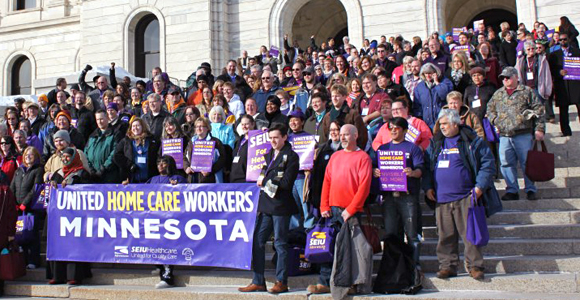

Share
Nazra Ahmed is a member of the bargaining team for SEIU Healthcare Minnesota and a home care worker who supports her autistic, nonverbal son.
Home care workers consider themselves frontline workers since they provide direct care, but they’re often ignored. For many living with long term disabilities, home care workers provide the necessary support and treatment to live independent lives. At an afternoon press conference, Ahmed argued that this contract both raises the bar and expands the public’s understanding of HCWs as frontline workers.
Ahmed also noted that this is the first time HCWs will have a floating holiday. For the diverse workforce, floating holidays allow workers to be responsive to their own culture and honor their religious holidays.
At the press conference, HCW Shari Lackey, who takes care of her son, explained that this is the largest wage increase for these workers. It will make the job more attractive. For Lackey, it was difficult to get help on low wages. Even before COVID, many seniors, people with disabilities, and the families that support them are without the care that they need to stay safely in their homes. It is expected that the increase in wages and benefits will play a key role in combating the care crisis.
Damon Lievestad is a client and was part of the bargaining team. He is one of many who need a HCW to live “healthy independent lives. ” For Lievestade, quality of life and the ability to contribute to society are directly tied to the gains made at the bargaining table.
The agreement was reached early Saturday morning, after more than 18 hours of bargaining between SEIU Healthcare Representatives and the State. This is the fourth agreement negotiated for home care workers.
The major gains include winning a $15.25 minimum wage for all home care workers in the second year of the two-year contract. The contract covers over 20,000 Minnesota home care workers beginning in July of 2021.
The full details of the tentative agreement are currently being shared with members who will have a chance to vote on its approval in the coming weeks, but highlights include:
- Minimum wage increased from $13.25 to $14.40 in October 2021 and to $15.25 in July 2022, a 15% increase
- More Paid Time Off: accrual rate improved from 1 hour per 40 hours worked to 1 hour per 30 hours worked
- Two new floating holidays paid at time-and-a-half each year, allowing home care workers to receive extra pay when their clients need care on religious holidays for the first time, and bringing the total time-and-a-half holidays in the union contract each year to 7
- Added funding to provide trainings and $500 stipends for home care workers who complete a set of training courses to enhance the quality of care they provide to seniors and people with disabilities
- A commitment to work together to research future options for further professionalization of the Minnesota home care workforce in the future, such as establishing a higher wage for long-time/experienced home care workers and providing better orientation to new home care workers
The Tentative Agreement now needs to get ratified by Union members. Then, it will go to the legislature for their approval and funding. The final step would be for Governor Walz to sign, and for it to go into effect July 1st, 2021, with some of its economic provisions taking effect on October 1st.
The negotiations took place in the months preceding budget negotiations in order to ensure that legislators have the opportunity to review the terms of the proposed agreement and vote on whether to ratify it. The bargaining team— made up of home care workers, clients and family caregivers—negotiated with the state over four months to reach this agreement.

